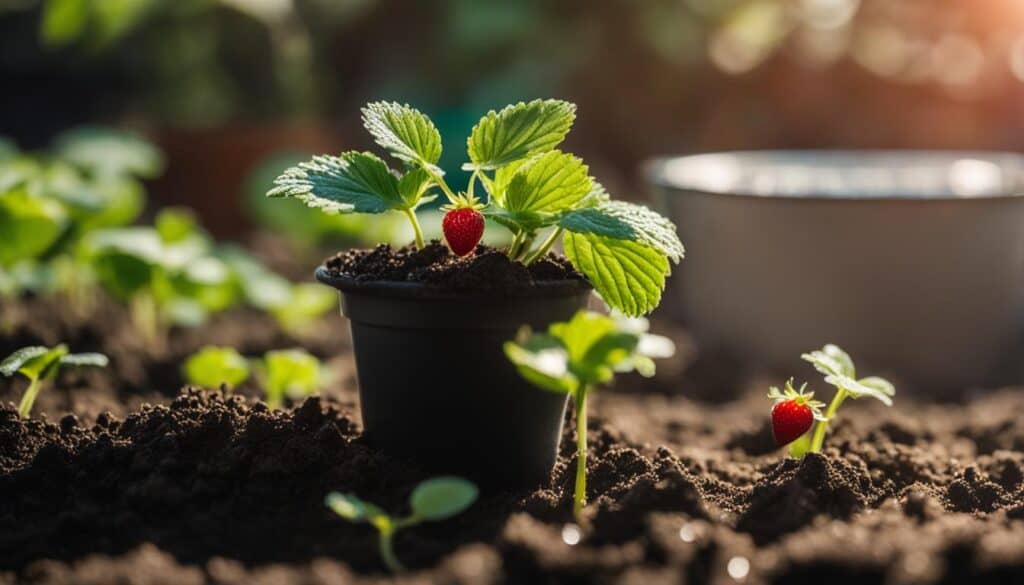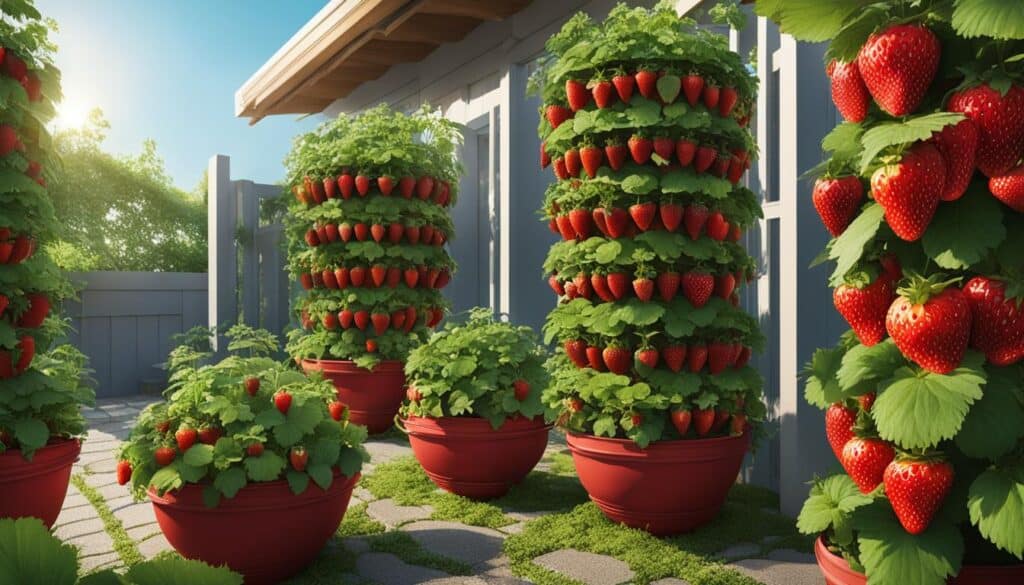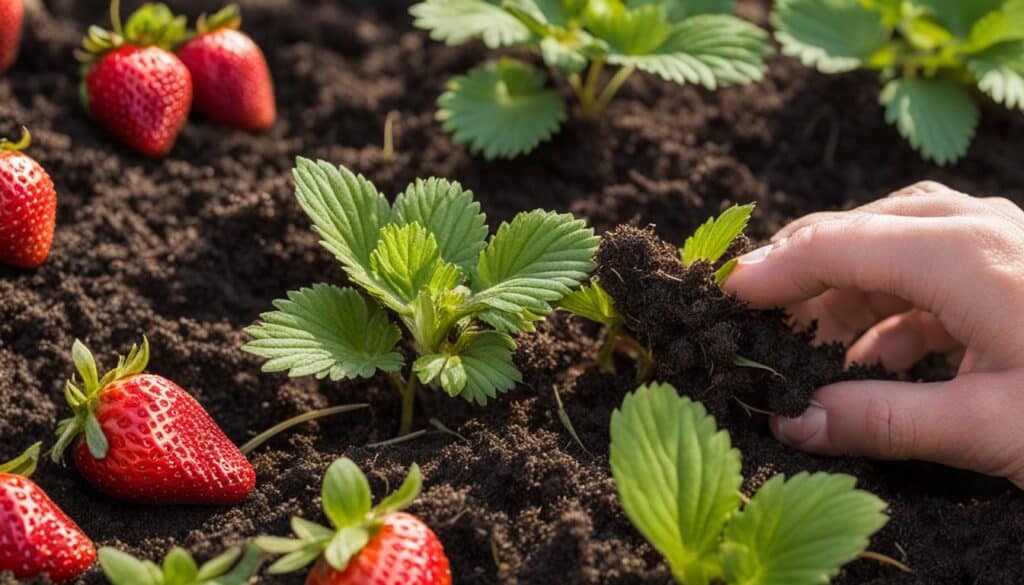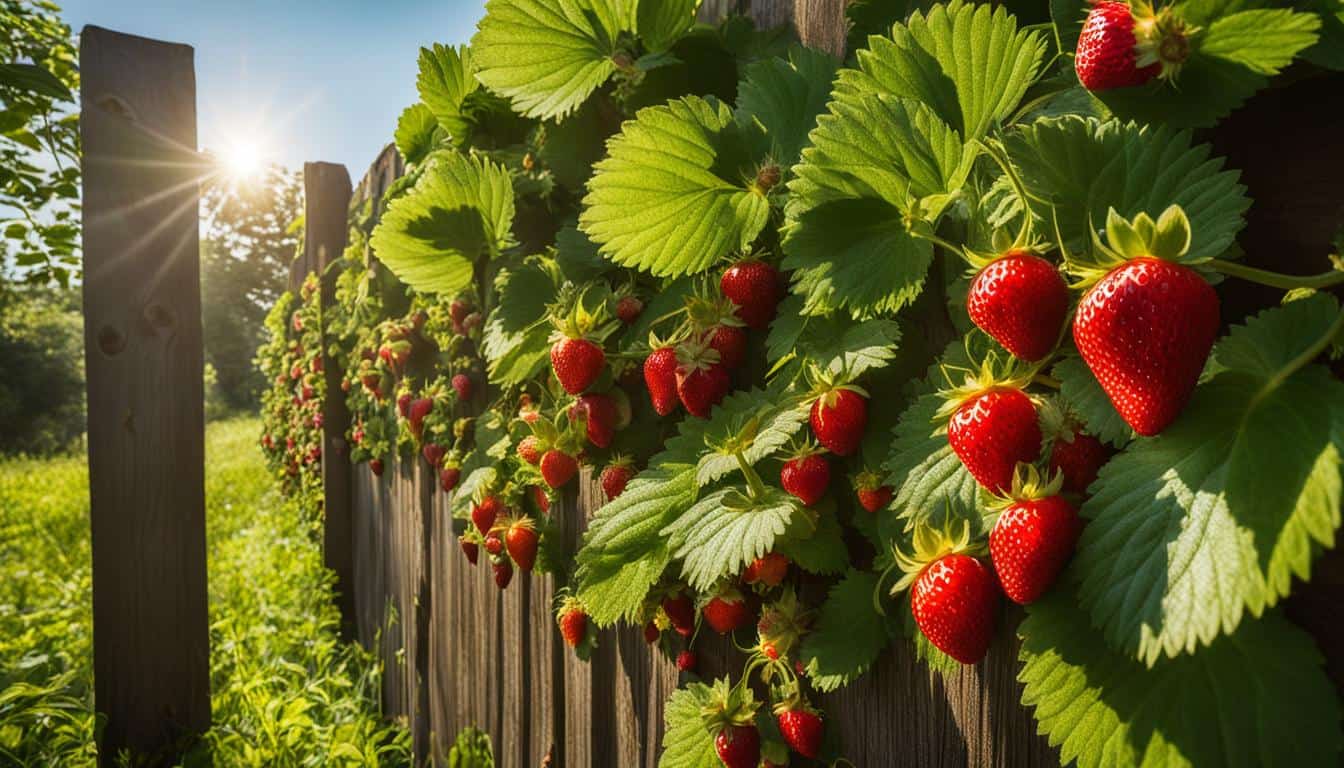Growing your own strawberries in a garden can provide you with the best tasting berries and is a rewarding experience. Strawberries are the first fruits to ripen in spring and offer a rich, aromatic flavor that is unmatched by store-bought strawberries. They can be grown in beds, rows, containers, strawberry jars, or hanging baskets. Starting with vigorous young Bonnie Plants® strawberry plants ensures the best results. Planting strawberries in spring or fall, providing them with at least 8 hours of sunlight, slightly acidic soil, and proper care such as watering, feeding, and pruning, will result in a bountiful crop of delicious berries.
Key Takeaways:
- Growing your own strawberries ensures the freshest and most flavorful berries.
- Strawberries can be grown in various ways, including beds, containers, and hanging baskets.
- Start with young, healthy strawberry plants for the best results.
- Provide strawberries with at least 8 hours of sunlight and slightly acidic soil.
- Proper care, including watering, feeding, and pruning, is essential for a successful harvest.
Quick Guide to Growing Strawberries
Best Time to Plant
Strawberries can be planted in either spring or fall, depending on your growing zone. In northern regions, it is best to plant in the spring, while in southern zones, fall planting is recommended. By aligning your planting time with the appropriate season, you can ensure that your strawberry plants have the best chance to thrive.
Choosing the Right Growing Method
There are several options for growing strawberries, including in-ground gardens, raised beds, containers, and strawberry jars. Each method has its own advantages and considerations. In-ground gardens provide ample space for plants to spread and are ideal for larger harvests. Raised beds can offer better drainage and soil control. Containers and strawberry jars are perfect for those with limited space or who want to grow strawberries on a patio or balcony. Choose the method that suits your needs and available resources.
Essential Growing Conditions
Strawberries require at least 8 hours of direct sunlight per day to produce optimal yields. They also prefer soil with a slightly acidic pH level, ranging from 5.5 to 6.8. If your soil is naturally alkaline, consider amending it with organic matter or using a premium potting mix. Adequate irrigation is crucial, with strawberries needing about 1 to 1.5 inches of water per week. Avoid wetting the leaves to prevent disease. Applying a continuous-release fertilizer will provide the necessary nutrients for healthy growth and bountiful fruit production.
| Growing Method | Advantages | Considerations |
|---|---|---|
| In-Ground Gardens | Ample space for plants to spread | Requires more land and maintenance |
| Raised Beds | Better drainage and soil control | May require additional setup |
| Containers and Strawberry Jars | Perfect for limited space | Requires regular watering |
By following these strawberry gardening tips and providing the best soil, planting, and care, you can enjoy a successful strawberry harvest. Experiment with different varieties to find the ones that thrive in your climate and taste the sweet rewards of your own homegrown strawberries.
The Strawberry Life Cycle

Growing strawberries at home is a rewarding experience, and understanding the life cycle of strawberries is key to successful cultivation. The strawberry life cycle consists of several stages, each with its own set of tasks and requirements.
1. Planting
The first stage of the strawberry life cycle begins with planting. Whether you choose to plant strawberries in the spring or fall, it’s important to start with healthy, young plants. Ensure that the planting site receives at least 8 hours of sunlight a day and has slightly acidic soil with a pH level between 5.5 and 6.8. Proper care, such as watering and feeding, is essential during this stage to establish strong roots and promote healthy growth.
2. Fruit Production
The next stage of the strawberry life cycle is fruit production. After the plants have established themselves, they will start to produce flowers. These flowers eventually develop into strawberries. To maximize fruit production, it is recommended to clip the runners (baby plants that grow from the main plant) to allow each plant to have a maximum of 3 daughter plants. This helps channel the plant’s energy into producing more fruit.
3. Resting and Preparing for Next Season
After bearing fruit and producing runners, strawberries generally rest during the summer months. This is a crucial period for the plants to recover and prepare for the next growing season. During this stage, the plants focus on growing foliage and developing buds for next spring’s flowers. It is important to provide proper care and maintenance to ensure the plants have the best chance of thriving during this resting period.
By understanding the different stages of the strawberry life cycle and providing the plants with the necessary care and attention, you can enjoy a bountiful harvest of delicious strawberries year after year. Whether you’re a beginner or an experienced gardener, growing strawberries at home is a delightful and rewarding endeavor. So grab your gardening gloves and get ready to nurture your own strawberry garden!
| Stage | Description |
|---|---|
| 1. Planting | The initial stage where young strawberry plants are established in a well-prepared planting site. |
| 2. Fruit Production | The stage where flowers develop into strawberries, and the plants focus on producing a bountiful crop. |
| 3. Resting and Preparing for Next Season | A period of rest and preparation for the plants to recover and develop buds for the next growing season. |
Soil, Planting, and Care
When it comes to growing strawberries successfully, the right soil, planting techniques, and proper care are crucial. Strawberries thrive in soil with a pH between 5.5 and 6.8, and they require at least 8 hours of sunlight each day. If your natural soil is alkaline or heavy clay, it is advisable to use premium potting mix or amend the soil with aged compost or rotted sawdust. This will help create a fertile and well-draining environment for your strawberry plants.
Proper planting is essential for the health and productivity of your strawberries. Make sure to space the plants 18-24 inches apart to allow for proper air circulation and prevent overcrowding. When planting, ensure that the crown of the plant is exposed to light and fresh air, as burying it too deep can lead to rotting. After planting, water the plants thoroughly to settle the soil and provide the necessary moisture for their establishment.
Regular care is essential for the success of your strawberry plants. Mulching with compost or other organic matter helps retain moisture, suppress weeds, and regulate soil temperature. It is also important to regularly feed your strawberry plants with a balanced fertilizer to provide them with the necessary nutrients for optimal growth and fruit production. Additionally, proactive weed control is crucial to prevent competition for resources and reduce the risk of diseases and pests.
Table: Comparison of Different Soil Types for Growing Strawberries
| Soil Type | Advantages | Disadvantages |
|---|---|---|
| Sandy Soil | Well-draining, warms up quickly in spring | Poor water retention, requires more frequent watering and fertilization |
| Loamy Soil | Well-draining, retains moisture, provides good nutrient availability | May compact over time, may require occasional aeration and addition of organic matter |
| Clay Soil | Rich in nutrients, retains moisture well | Poor drainage, heavy texture can lead to compaction and waterlogging |
By providing the right soil conditions, proper planting techniques, and regular care, you can ensure the health, productivity, and deliciousness of your strawberry plants. Enjoy the process of growing your own strawberries and savor the sweet rewards of your efforts!
Varieties of Strawberries
When it comes to growing strawberries, choosing the right variety is essential for a successful harvest. There are three main categories of strawberries: June-bearing, ever-bearing, and day-neutral. Each category has its own unique characteristics and fruiting habits.
June-bearing Strawberries
June-bearing strawberries are the most common type and produce a large crop of berries in the spring. These varieties are known for their intense flavor and juicy texture. They are ideal for fresh eating and are perfect for making jams and desserts. Popular June-bearing varieties include Allstar, Chandler, and Jewel.
Ever-bearing Strawberries
Ever-bearing strawberries offer the advantage of producing two harvests, one in summer and another in fall. These varieties are known for their smaller-sized berries but are still packed with flavor. They are great for snacking or adding to salads. Top ever-bearing varieties include Albion, Seascape, and Ozark Beauty.
Day-Neutral Strawberries
Day-neutral strawberries are unique in that they produce fruit continuously throughout the growing season, regardless of the length of daylight. This makes them a favorite for home gardeners who want a constant supply of fresh strawberries. Day-neutral varieties like Tristar, Tribute, and Aromas are known for their sweet flavor and firm texture.
When selecting a strawberry variety, consider your climate, growing conditions, and personal preferences. Some varieties perform better in certain regions, so it’s worth trying different types to find the best fit for your garden. Whether you choose June-bearing, ever-bearing, or day-neutral strawberries, you’ll be rewarded with delicious, homegrown berries that are far superior to store-bought options.
| Category | Popular Varieties |
|---|---|
| June-bearing | Allstar, Chandler, Jewel |
| Ever-bearing | Albion, Seascape, Ozark Beauty |
| Day-Neutral | Tristar, Tribute, Aromas |
Container Gardening for Strawberries

Growing strawberries in containers is a practical and rewarding way to enjoy fresh, homegrown berries even if you have limited space. Containers offer the advantage of portability, allowing you to move your strawberry plants to the sunniest spots in your garden or even bring them indoors during inclement weather. They also provide protection against pests and diseases, ensuring that your strawberries remain healthy and productive. To successfully grow strawberries in containers, here are a few key tips to keep in mind:
Choosing the Right Container
When selecting a container for your strawberry plants, opt for one that is at least 12 inches deep to accommodate the plant’s root system. Ensure that the container has drainage holes to prevent waterlogged soil, as strawberries prefer well-draining conditions. Consider using strawberry urns, hanging baskets, grow bags, or pyramid planters for an aesthetically pleasing and space-saving option.
Using the Proper Soil
Strawberries thrive in slightly acidic soil with a pH range of 5.5 to 6.8. Use a high-quality potting mix specifically formulated for containers, as it provides good drainage and aeration. You can also add organic matter like compost or well-rotted manure to enrich the soil and promote healthy growth.
Providing Ample Sunlight and Water
Like all plants, strawberries need sunlight to thrive. Place your containers in a location that receives at least 6 to 8 hours of direct sunlight per day. Regularly water your strawberry plants, ensuring that the soil remains evenly moist. Avoid overwatering, as it can lead to root rot.
Fertilizing and Pruning
Regular feeding with a balanced fertilizer specifically formulated for strawberries will help promote healthy growth and fruit production. Follow the manufacturer’s instructions for application rates and frequency. Additionally, prune your strawberry plants to remove any dead or yellowing leaves, as well as runners that develop. This will help divert the plant’s energy towards fruit production.
By following these container gardening tips, you can enjoy a bountiful harvest of sweet and juicy strawberries right at your fingertips. Whether you have a small balcony or a spacious patio, growing strawberries in containers is a convenient and enjoyable way to cultivate your own delicious berries.
| Advantages of Container Gardening for Strawberries |
|---|
| 1. Portability, allowing you to position your plants for maximum sunlight exposure |
| 2. Protection against pests and diseases |
| 3. Ideal for small spaces, such as balconies, patios, and decks |
| 4. Easy maintenance and accessibility for watering, feeding, and pruning |
Troubleshooting Strawberry Growing Problems
Growing strawberries in your garden can be a delightful experience, but like any plant, strawberries can encounter problems. Understanding these common issues and knowing how to address them can help ensure a successful strawberry harvest. Here are some of the most common strawberry problems and their solutions:
Pest Control
One of the most prevalent problems that strawberry plants face is slug damage. Slugs can quickly decimate a crop by munching on the leaves and berries. To deter slugs, consider using plastic mulch around the plants, as the slippery surface can make it difficult for them to crawl. Additionally, you can handpick slugs off the plants or use organic slug control methods.
Diseases
Fungal diseases can also affect strawberry plants, particularly in humid or wet conditions. Gray mold (Botrytis fruit rot) and powdery mildew are common fungal diseases that can impact strawberries. To prevent these diseases, ensure the plants have good air circulation by thinning out crowded growth. Remove any infected leaves or fruit promptly, and consider using organic fungicides if necessary.
Bird Predation
Birds are notorious for feasting on ripe strawberries, leaving you with little to enjoy. To protect your berries from avian predators, cover the plants with lightweight netting. This will prevent birds from reaching the fruit while still allowing sunlight and airflow to reach the plants. Be sure to secure the netting tightly to prevent birds from getting trapped.
Environmental Factors
Heat and drought can lead to small, deformed berries. Ensure that your strawberry plants receive enough water, especially during hot and dry periods. Mulching the soil around the plants with organic matter can help retain moisture and regulate soil temperature. Providing proper care and being attentive to the plants’ needs will help them overcome environmental challenges.
| Problem | Solution |
|---|---|
| Slug Damage | Use plastic mulch or handpick slugs. Consider organic slug control methods. |
| Fungal Diseases | Ensure good air circulation, remove infected leaves or fruit, consider using organic fungicides. |
| Bird Predation | Cover plants with lightweight netting to deter birds while allowing sunlight and airflow. |
| Heat and Drought | Ensure plants receive enough water and mulch around them to retain moisture. |
By addressing these common strawberry problems promptly and effectively, you can help your plants thrive and enjoy a bountiful harvest of delicious strawberries.
Harvesting and Storing Strawberries
When it comes to picking strawberries, timing is everything. The best time to harvest strawberries is early in the morning when the berries are cool. Ripe strawberries should be bright red and fully colored, with a sweet aroma. If you see any white spots, it indicates that the strawberry needs a few more days to ripen. To avoid bruising or damaging the berries, handle them carefully, holding the stem between your thumb and forefinger, and gently twist and pull.
After picking, it is important to store your strawberries properly to maintain their freshness. Place the strawberries in a shallow container and refrigerate them right away. Avoid washing the berries until you’re ready to eat or use them. Before consuming, rinse the strawberries with cool water to remove any dirt or debris.
If you have overripe strawberries, don’t worry! You can still put them to good use. Freeze them to use in smoothies or desserts, or dry them for a tasty snack. You can also create delicious jams and preserves with overripe strawberries. Simply cook them down with sugar and lemon juice until you reach a thick, spreadable consistency.
“The taste of a freshly picked, ripe strawberry is like no other. It’s the perfect balance of sweetness and tartness that simply melts in your mouth.”
Tips for Storing Strawberries
- Refrigerate strawberries as soon as possible after picking or purchasing them.
- Store strawberries in a shallow container to avoid crushing them.
- Avoid washing strawberries until you’re ready to eat or use them.
- Rinse strawberries with cool water before consuming.
- Freeze overripe strawberries for future use.
By following these tips, you can enjoy the fresh and delicious taste of homegrown strawberries for longer periods. So go ahead, venture into your garden and pick those juicy red gems!
Overwintering Strawberry Plants

During the winter months, it is essential to provide proper care and protection for your strawberry plants to ensure their survival and a bountiful harvest in the next growing season. Proper winter care includes insulating the plants in colder climates, moving them to a protected area or covering them with mulch in warmer climates, and providing adequate air circulation.
In colder climates, after a few frosts, you can insulate your strawberry plants with straw mulch. Spread a layer of straw around the plants, ensuring that the crowns are covered but the leaves remain exposed. This protective layer of mulch helps to regulate the temperature around the plants and prevent damage from freezing temperatures. In the following spring, remove the mulch to allow the plants to receive sunlight and air.
In warmer climates, you can move your strawberry plants to a cool and protected area, such as a shed or garage, during the coldest months. Alternatively, you can cover the plants with mulch to safeguard them against frost. Be sure to choose a mulch material that allows for adequate air circulation to prevent mold or fungus growth. Once the danger of frost has passed, uncover the plants and provide them with proper sunlight and care.
Ensuring Adequate Protection
Regardless of your climate, it is crucial to provide adequate protection for your strawberry plants during the winter months. Protecting them from extreme temperature fluctuations, frost, and excessive moisture will help prevent damage and ensure their survival. Additionally, providing proper air circulation is essential to prevent the growth of mold or fungus that can harm the plants.
By following these winter care practices and providing the necessary protection, you can ensure the health and longevity of your strawberry plants. This will enable them to thrive and produce a bountiful harvest of delicious strawberries in the upcoming growing season.
Conclusion
Growing strawberries in your own garden is a fulfilling experience that allows you to enjoy the freshest and most flavorful berries. By following the proper planting and care techniques, you can create an ideal strawberry garden. Whether you grow them in beds, containers, or hanging baskets, strawberries provide a rich and aromatic flavor that is unparalleled by store-bought options.
Experiment with different varieties to discover your favorites and provide proper sunlight, soil, and water to ensure their optimal growth. Throughout the growing season, it is important to tend to the plants’ needs, including watering, feeding, and pruning. With patience and care, you can have a successful strawberry garden that provides a bountiful harvest for years to come.
FAQ
When is the best time to plant strawberries?
Plant strawberries in spring or fall based on your growing zone.
How should I plant strawberries?
Strawberries can be grown in various ways, such as in-ground gardens, raised beds, containers, or strawberry jars.
What conditions do strawberries need to grow?
Strawberries require at least 8 hours of sun and slightly acidic soil with a pH of 5.5 to 6.8.
How should I care for my strawberry plants?
Water the plants 1 to 1.5 inches per week, avoid wetting the leaves, and use a continuous-release fertilizer to promote fruit production. Prune and remove foliage as needed.
What types of strawberries are there?
Strawberries come in three main categories: June-bearing, ever-bearing, and day-neutral.
Can strawberries be grown in containers?
Yes, strawberries can be successfully grown in containers such as strawberry urns, hanging baskets, grow bags, and pyramid planters.
What are some common issues strawberries face?
Strawberries can face slug damage, fungal diseases, bird predation, heat, and drought.
When should I harvest strawberries?
Harvest ripe strawberries early in the morning when they are cool and before they attract birds and bugs.
How should I store strawberries?
Refrigerate picked strawberries right away to maintain freshness and rinse with cool water before eating or using.
How do I overwinter strawberry plants?
In colder climates, insulate plants with straw mulch, and in warmer climates, move them to a cool, protected area or cover with mulch to safeguard against frost.





Leave a Reply